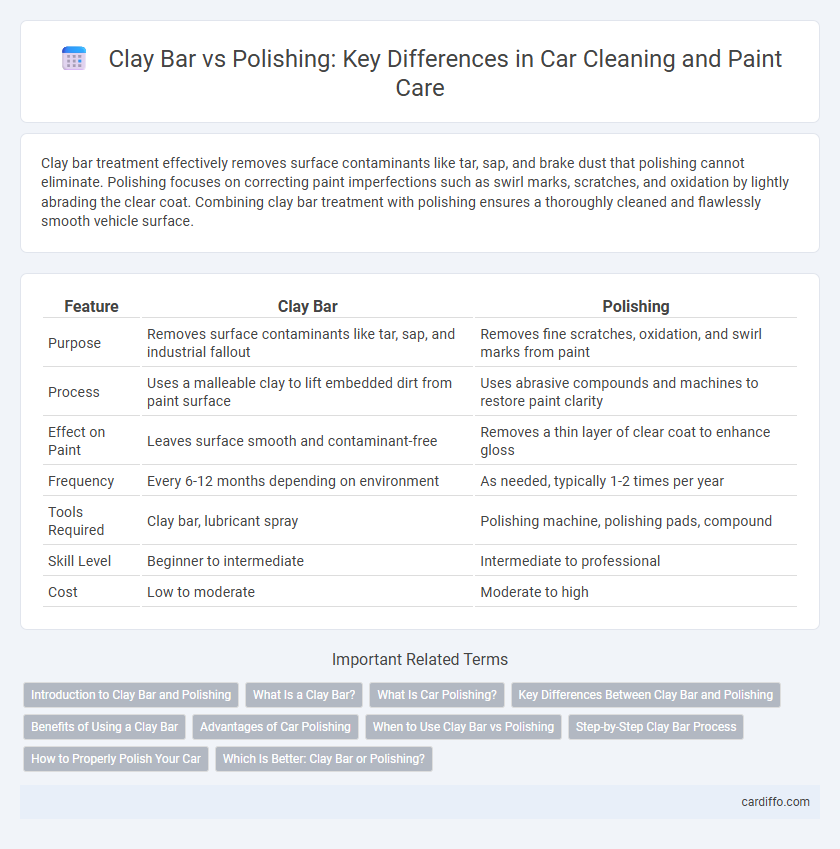Clay bar treatment effectively removes surface contaminants like tar, sap, and brake dust that polishing cannot eliminate. Polishing focuses on correcting paint imperfections such as swirl marks, scratches, and oxidation by lightly abrading the clear coat. Combining clay bar treatment with polishing ensures a thoroughly cleaned and flawlessly smooth vehicle surface.
Table of Comparison
| Feature | Clay Bar | Polishing |
|---|---|---|
| Purpose | Removes surface contaminants like tar, sap, and industrial fallout | Removes fine scratches, oxidation, and swirl marks from paint |
| Process | Uses a malleable clay to lift embedded dirt from paint surface | Uses abrasive compounds and machines to restore paint clarity |
| Effect on Paint | Leaves surface smooth and contaminant-free | Removes a thin layer of clear coat to enhance gloss |
| Frequency | Every 6-12 months depending on environment | As needed, typically 1-2 times per year |
| Tools Required | Clay bar, lubricant spray | Polishing machine, polishing pads, compound |
| Skill Level | Beginner to intermediate | Intermediate to professional |
| Cost | Low to moderate | Moderate to high |
Introduction to Clay Bar and Polishing
Clay bar treatment removes embedded contaminants from automotive paint surfaces, restoring smoothness by lifting bonded particles like industrial fallout, tree sap, and brake dust. Polishing further refines the paint by using abrasives to correct minor scratches, swirl marks, and oxidation, enhancing gloss and clarity. Both processes complement each other, with clay bar preparing the surface for effective polishing and improved finish durability.
What Is a Clay Bar?
A clay bar is a detailing tool made of synthetic resin designed to remove contaminants like industrial fallout, brake dust, and tar from a vehicle's paint surface. Unlike polishing, which smooths and refines the paint by removing a thin layer, clay bar treatment lifts embedded particles without altering the clear coat. Using a clay bar restores a smooth, clean surface that enhances paint clarity and prepares it for waxing or polishing.
What Is Car Polishing?
Car polishing involves using abrasive compounds to remove a thin layer of the clear coat, eliminating surface imperfections such as scratches, oxidation, and swirl marks to restore a vehicle's gloss and smoothness. Unlike clay bar treatment, which removes contaminants bonded to the paint surface, polishing works by refining and leveling the paint, enhancing the car's overall appearance. Polishing is typically performed after decontamination steps like clay barring to ensure a clean surface for optimal results.
Key Differences Between Clay Bar and Polishing
Clay bar removes surface contaminants like tar, sap, and industrial fallout that washing cannot eliminate, providing a smooth base for further detailing. Polishing uses abrasive compounds to refine the paint, eliminating minor scratches, swirl marks, and oxidation for a glossy finish. While clay bar focuses on decontamination, polishing enhances paint clarity and depth.
Benefits of Using a Clay Bar
Using a clay bar effectively removes embedded contaminants such as industrial fallout, brake dust, and tar from the vehicle's surface, resulting in a ultra-smooth finish. It provides superior paint surface preparation for polishing or waxing by eliminating surface impurities without removing clear coat material, preserving the integrity of the paint. This process enhances the overall appearance and longevity of the paintwork while ensuring better adhesion of subsequent protective layers.
Advantages of Car Polishing
Car polishing enhances paintwork by removing fine scratches, oxidation, and swirl marks, restoring a smooth and glossy finish. It protects the vehicle's surface by sealing pores and filling minor imperfections, which extends the lifespan of wax or sealant applications. Polishing also improves paint clarity and depth, increasing the car's overall aesthetic appeal and resale value.
When to Use Clay Bar vs Polishing
Use a clay bar when removing surface contaminants like tar, sap, or industrial fallout that washing alone cannot eliminate, restoring smoothness without altering the paint's clear coat. Polishing is necessary for correcting paint imperfections such as swirl marks, scratches, and oxidation by removing a thin layer of the clear coat to enhance gloss and clarity. Opt for clay bar treatment before polishing to ensure contaminants are eliminated, allowing the polish to work more effectively.
Step-by-Step Clay Bar Process
The step-by-step clay bar process begins with thoroughly washing and drying the vehicle to remove surface dirt. Next, generously spray lubricant on a small section of the paint, then gently glide the clay bar over the surface to lift embedded contaminants. After each pass, fold the clay bar to expose a clean side, and repeat until the entire vehicle is contaminant-free, enhancing the paint's smoothness before polishing.
How to Properly Polish Your Car
Properly polishing your car begins with thoroughly washing and claying the surface to remove contaminants and prepare for a smooth finish. Use a dual-action polisher with an appropriate polishing compound, working in small sections with consistent pressure to enhance paint clarity and remove minor imperfections. Finish by wiping down with a microfiber cloth and applying a protective wax or sealant to maintain the polished shine.
Which Is Better: Clay Bar or Polishing?
Clay bar removes surface contaminants like tar, overspray, and industrial fallout, providing a cleaner, smoother paint surface. Polishing eliminates minor scratches, swirl marks, and oxidation by removing a thin layer of clear coat to restore shine. For deep paint correction, polishing is better, while clay bar is ideal for surface preparation before waxing or polishing.
Clay bar vs Polishing Infographic

 cardiffo.com
cardiffo.com